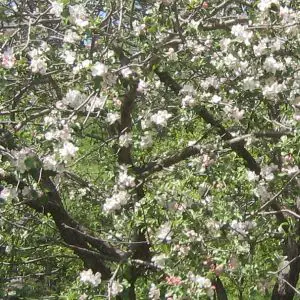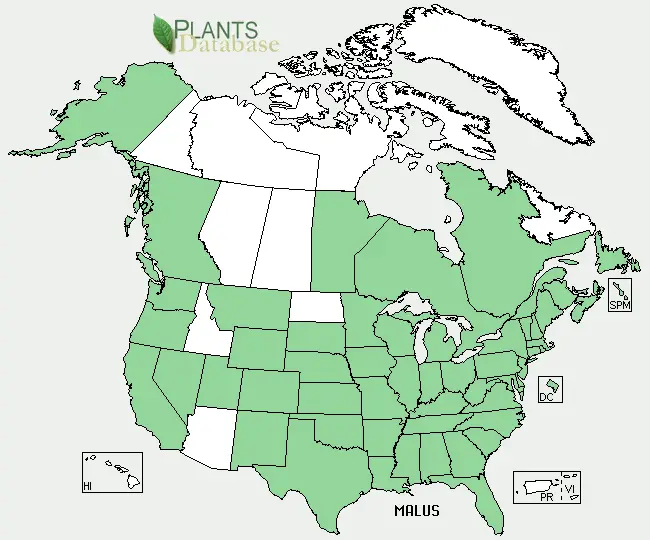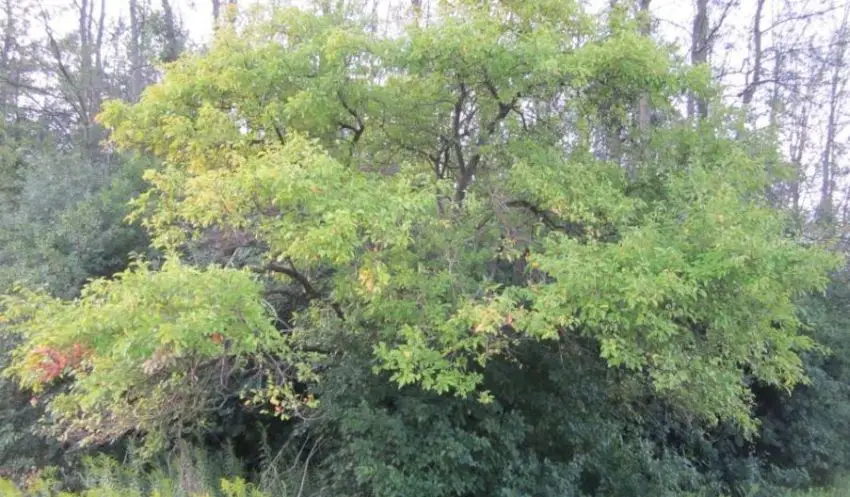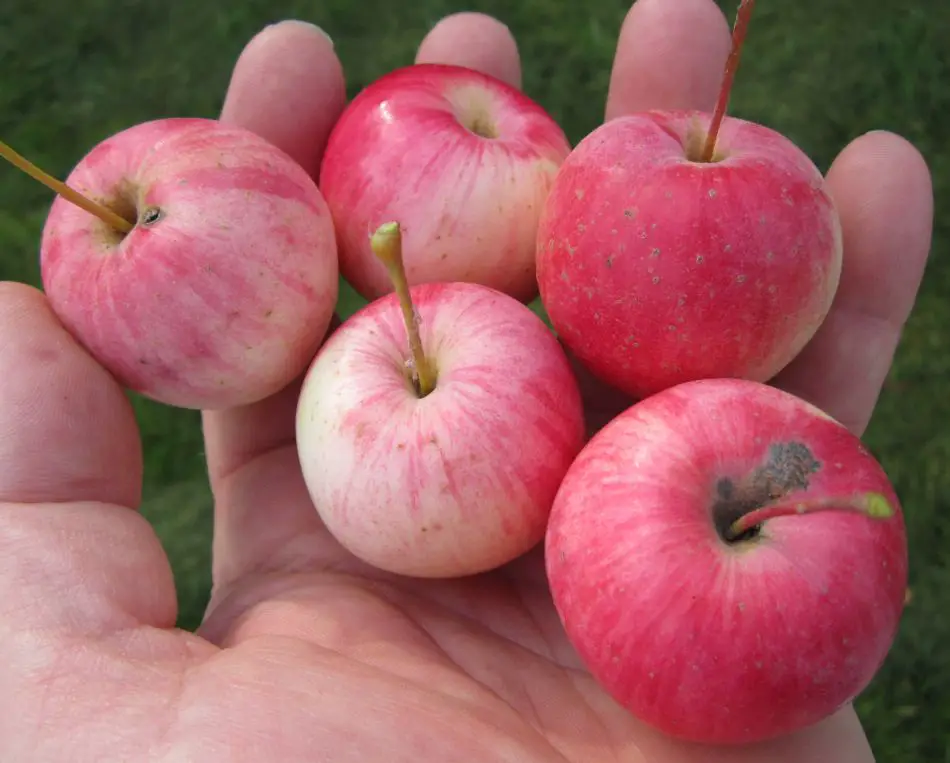
Search Wild Foods Home Garden & Nature's Restaurant Websites:
Apple Tree

Apple trees (Malus domestica). It may seem odd to include Apple trees in a book about growing wild food, but Apple trees have escaped cultivation and are growing wild in most of Eastern North America. Also, this is probably the first tree people think of when getting a tree as part of an edible landscape, and for good reason. Everyone who has the room should have at least one Apple tree.
A very interesting thing about Apple trees is the unusual way they pass on the genetics from the parent tree to the seeds. With the vast majority of plants, the offspring produced by that plant are similar to the parent plant. This is the foundation on which breeding of plant and tree species is based on. Apple trees are different. Each time an Apple tree produces seeds, it throws the genetic dice, and the seeds can, and will produce Apple trees that are not similar to the parent tree. Seeds from one tree's apple can produce trees with apples of different shapes, colors and tastes. When a tree is found that produces excellent apples, clones are made of that tree to keep the line going. Most apple trees you run across that are not from orchards, or that have not been intentionally planted are from seed, and so, you never know what you are going to get. Some are bitter, some sweet, some tart, etc. You just have to taste a wild Apple to see.
One way to view this information, is to stick to clones of trees of known types. This is the most common strategy for many good reasons. Many people have put their lives into growing, cloning and grafting the best they can and have come up with high yielding dwarf trees that produce early in their life fantastic Apples with rootstock that withstands the conditions in your area. That is the route most should take. By purchasing trees of this kind, you can be eating fruit from them remarkably quickly.
You can however, just want to grow the trees for the sake of having natural Apple trees, and use what you get. I had an Apple tree of this type on my property when I lived in Central Ontario in a Log Cabin. The tree was very old, and from what I was told by the grandson of the man who built the log cabin which was built around 1907, that the tree was planted by seed, along with many others, in the 1940's. The tree produced heavily, and the red/green Apples, though tart, were very good, and made great Apple pies. I've never tasted Apples quite like it, as it was not one of the breeds that are cloned. Also, this tree was beautiful in a way you will never see in a dwarf tree.
However, around that tree there were two other wild Apple trees. One had sweet yellow Apples that were very good for eating fresh off the tree. When you took a bite out of one of these, the flesh would turn brown in seconds, so once you started, you had to finish it quickly. But the Apples from the other one tasted like bitter soap. I tried one each year over three years, but every apple on that tree was the same. Even the worms and wildlife left that tree alone. To this day, it is one of the worst things I have ever tasted. So, now that you know how it works, make a choice and buy a proven species or throw the dice with seeds. One more thing, if you plant a seed, it can be many years before you get fruit.
Assuming you decide to buy one locally, talk to the people at the nursery. They should ask you questions like, what do you want the fruit for - eating fresh, or cooking, or that lasts in storage, that is tart, is sweet, what is you favorite store bought apple, and so on. They should also ask what the site and soil is like where you are going to grow it. If they don't, I'd move on to another nursery. If your choices of nursuries are limited, decide on all of this ahead of time, read about varieties of apples and see what meets your needs and will grow happily in your area. Even if you do this yourself, I'd still recommend a nursery that gets into all of this and has years of experience. A good choice will pay off for years, while a poor choice will frustrate for years.
Soil & Site: Apple trees will grow in a huge range of conditions and soils. As long as they get full sun and are not planted in a swamp, desert or on bare rock, it should grow and produce. They will do best in slightly acidic, organic rich loam that is moist and well drained.
Planting: So, you come home with your new Apple tree. The best advice I can give, is to follow the advice of the nursery. They will know your area soils, and tell you what should be done to prepare. Generally however, good advice is to have the hole prepared much bigger than needed, the soil from the hole mixed with some composted manure and sitting by the side of the hole. If your soil is hard clay, I'd suggest mixing in lots of peat and sand with it. If it is almost pure sand, mix in lots of organic matter.
If the tree came in a pot, before you put it in the ground you might want to untangle the roots so the tree will not strangle itself as it grows. You should speak to the staff where you purchase your tree, as sometimes the guarantee that comes with the tree can be affected if you take off soil from the root ball. Trees dying from being strangled by their own roots happens a few years after being planted, and the problem is very common. A good nursery will explain how to prevent this. Also, a good nursery will prune roots and not sell you a tree that has long roots wrapped around the inside of the pot. This is an important issue to talk to the nursery about. Look here to see what happens if this issue is not understood.
Maintenance: Once you have a tree that is producing fruit, you probably will need to maintain a regular program of pest control. Dormant oil is what I used when I ran a landscaping business. It works well if you do it right, but that means a carefully done job so that you don't miss anything and do it at the right time. Also, if you live where there are raccoons (where isn't there now?), be prepared to have to come up with ingenious methods of keeping them away from the tree. I found when I lived in the woods of Central Ontario I didn't need to do anything, and rarely had wormy Apples. I don't know why, but my guess is that because I was in the middle of thousands of acres of conifer forests, the pests didn't have many hosts locally to live on and spread to my tree.
Fruit tree pruning was one of my favorite jobs when I had the landscaping business. Some of the work I did just seemed like hard labour, but pruning was like artwork. The tools you need and the approach to take depends on the job you have. If it is a small tree recently planted, a good pair of hand pruners is all you need. If you have an old, large tree, you will need a pruning saw, loppers, and a pole saw. I cannot cover all the situations here, so I've listed some search links that should give you a starting point of how to proceed. If you are planting a new tree purchased from a nursery, yet again I advise listening to what they say to do for the particular cultivar you are planting.
Pruning that is for shaping or training should be done in the very early spring or late winter after the chance of very low temperatures and before the leaves or flowers come out. If there is dead wood, that is really best noticed when the leaves are out, so take out dead branches while you can see them so that the next spring you don't leave a dead branch and take out good ones when pruning - otherwise you could leave a gap where there is nothing. Ground suckers should be taken out as they come up, and if your tree produces many of these ground suckers, go to a garden store or nursery and tell them you want a product to stop this. There are certain times of the growing season that you should and should not use these.
Before you follow any of the links below and go ahead and start to prune, I'm going to give you one piece of advice that I don't read often enough: When inexperienced at pruning, don't do it all at once. Read, look at pictures, get an idea of what you want to achieve, then go out and do no more than about a third of the pruning. Then give it a day, look at the tree, read a little, look a pictures, then when you have a good idea of what you want to do next, do another third. Repeat the looking, reading, thinking about it, then finish. Some day you will just be able to go out and do it all at once, but I can honestly say I wish someone had given me this advice when I first started. This advice is of utmost importance when trying to restore an old tree that has been let go. Remember - you can't re-attach a mistaken cut.
Web Resources for Pruning:
- Instructions for pruning Apple trees here.
- Images for pruning Apple trees here. This is helpful, as it is a very good idea to visualize what you want the tree to look like before you start.
- Videos on how to prune an Apple tree here.
- Diagrams showing how to prune an Apple tree here.
- If you have an older Apple tree here.
- Instructions for cutting tree branches here.
- Diagrams for cutting a tree branch here.
Description:
- USDA Plant Hardiness Zone: 3-11, however each cultivar and grafted tree has its own best climate match (More information on hardiness zones).
- Soil pH: 6.0-7.0 in general is the best range
- Plant Size: Tree
- Duration: Can live over 100 years
- Leaf Shape: Ovate
- Leaf Phyllotaxis (Arrangement) on branch: Alternate
- Leaf Size: Up to 7.5 cm (3 inches) long
- Leaf Margin: Serrated (saw toothed edge)
- Leaf Notes: Often asymmetrical base of the leaf where it meets the stem. Color is dark green. The leaf margins are bent upwards as well as serrated (sawtooth).
- Flowers: Five petalled, white to pink. 3 to 4 cm (1.1/5 to 1 3/5 inches) diameter, Inflorescence (cluster) of 4 to 6 flowers
- Fruit: Variable in size and color, red, green, yellow & mixes of those colors. From golf ball sized to 10 cm (4 inches) in rare cases
- Bark: Young branches or trunk can be smooth with dots or horizontal checking, grey to reddish grey to sometimes a faint purplish hue. Older trunks are scaly, with flaking of scales. Medium age trunks can be a mix - smoother sections and scaly areas.
- Habitat: Very adaptable to a wide range of habitats. Does not grow in dark shade or constantly wet ground like shallow marshes.
Web Resources:
- Recipe search on the web here (Google search) and here (Bing search).
- Pictures on the web here (Google images) and here (Bing images).
- Interactive USDA distribution map and plant profile here.
- The Biota of North America Program (BONAP) distribution map here. BONAP map color key here.

b>Apple tree (Malus domestica) range. Distribution map courtesy of U. S. Department of Agriculture (USDA Natural Resources Service) and used in accordance with their policies.

A wild apple tree found on the edge of a woods. The apples from this tree were small but beautiful looking and sweet tasting - a really nice find.

This is some of the harvest from this tree in my hand. These were fantastic apples even though they were very small in size.
Search Wild Foods Home Garden & Nature's Restaurant Websites:
Share:
Why does this site have ads?
Originally the content in this site was a book that was sold through Amazon worldwide. However, I wanted the information to available to everyone free of charge, so I made this website. The ads on the site help cover the cost of maintaining the site and keeping it available.
Google + profile
